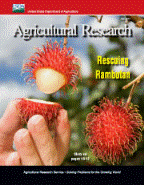United States Department of Agriculture: Agricultural Research Service, Lincoln, Nebraska

Agricultural Research Magazine
Date of this Version
4-2013
Document Type
Article
Citation
Agricultural Research April 2013.
Abstract
Whole-grain brown rice contains 15 vitamins and minerals, including B vitamins, potassium, magnesium, and iron—all nutrients the body needs to grow and develop normally. In addition to these essential nutrients, there are bioactive phytochemicals in rice, as well as in other whole grains, vegetables, fruits, beans, nuts, and seeds. Although the role of these plant chemicals in terms of human health has not been proven, a body of evidence suggests that some phytochemicals could be nutritionally beneficial.
Now, studies headed by chemist Ming-Hsuan Chen, who is with the Agricultural Research Service’s Dale Bumpers National Rice Research Center in Stuttgart, Arkansas, have provided knowledge about the chemical composition and potential bioavailability of compounds in a representative group of rice varieties.
Rice is a cereal grain, along with corn, oats, red and white wheat, and barley. The USDA-ARS National Small Grains Collection (NSGC) in Aberdeen, Idaho, for example, contains more than 18,000 rice samples of various colors, called “accessions,” from around the world. These accessions provide a valuable resource to breeders for developing new rice varieties with desirable agronomic and nutritional features.
Rice is categorized into seven color classes based on bran color: white, light brown, speckled brown, brown, red, variable purple, and purple.
Included in
Agriculture Commons, Animal Sciences Commons, Food Science Commons, Plant Sciences Commons

